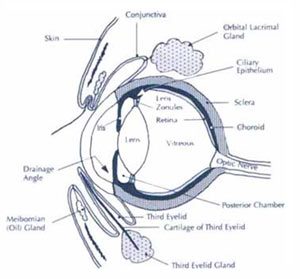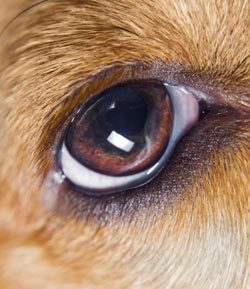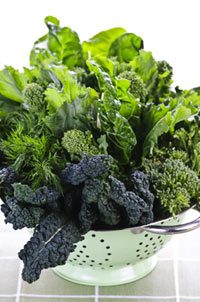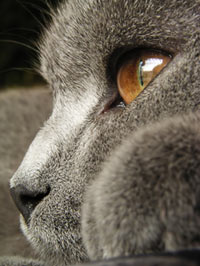“Your Pet’s Eyes Are Gateways to the World: Are You Doing All You Can to Support Their Health?”
There’s an old English proverb that says the eyes are the window to the soul. And now it appears that scientists may have confirmed this.
According to research in humans, patterns in the iris, or the colored portion of the eye, can give clues to your personality and reveal certain traits like warmth, trust, or even impulsiveness.
While this may be true for your pet, too, his or her eyes tell far more… Your pet uses her eyes to communicate with you. Her eyes tell you she’s ready for a walk. Or wants to play. And that she’s happy.
Your pet’s eyes are one of her most precious – and complex – organs. And because they are so important to her well being throughout her life, obviously, you want to do all that you can to help support and maintain her healthy eye function.
I’d like to suggest some ways you can do that – some of which may be new to you. And these are things that are best started as soon as possible. Your pet is never too young for eye health support.
First, let’s take a look at some of the more interesting features of cat and dog eyes…
The Anatomy of Your Pet’s Eye

Although their eyes may look very similar to human eyes, the eyes of cats and dogs eyes differ in a number of ways:
- Dogs and cats have very large pupils to see better in dim light conditions.
- Cats’ eyes have a figure-8 muscle that closes way down to a slit.
- Dogs and cats have more rods than cones. Rods are used for detecting movement rather than color and details.
- Cats and long-nosed dogs have a “visual streak” that allows them to focus sharply at a distance, and gives them great peripheral vision.
- Short-nosed dogs have high density vision cells instead of a visual streak that gains them an advantage in reading their owner’s facial expressions.
- Cats and dogs have a third eyelid (called the nictitating membrane) that works as a thin shutter to protect the eyeball.
Indeed, dogs and cats have unique eyes and visual systems. And at least with dogs, it appears that the way their eyes work may align with what they were bred to do…
Understanding Your Pet’s Way of Seeing the World
To fully appreciate your pet’s sense of vision, you need to know how your cat or dog’s view of the world differs from your own.
The average dog’s visual acuity is sometimes compared to that of a human’s at sunset. There are exceptions, but most dogs see forms rather than distinct images or features.
Dogs especially rely on their keen sense of smell to “read” their world, so for them, vision is secondary.
Cats are a different story…
Cats by nature are nocturnal hunters so visual acuity is important. The unique slit-shaped design of their pupils allow them to see well in dim light, and their ability to focus on objects and detect movement is highly refined.
But unlike what many may believe, cats can’t see well in pitch black darkness.
Dogs and cats have evolved in a natural world where darkness offers advantages – and sometimes the key to survival. Wild dogs escape to their dens to rest in safety and away from the glaring sun.
In the wild, cats and dogs move freely in ever-changing light conditions. In contrast, their modern day ancestors – our pets – live in an artificially lit world that may be stressful for them and their vision, just as it can be for us, too, at times.
I recommend having at least one area in your home where your pet can retreat into darkness, or at least escape the continuous glow and glare of artificial, fluorescent lights.
And if they spend a lot of time outdoors, be sure they have a shady spot.
How Healthy Are YOUR Pet’s Eyes?

I don’t think many pet owners realize it, but your pet’s eyes can provide valuable clues about his or her health because they’re connected to both the vascular and neurological systems.
Do you know the characteristics of healthy eyes? The ASPCA offers 9 eye health tips that can help you recognize healthy eyes in your pet and spot clues to less-than-optimal health that warrants a visit to your veterinarian or eye specialist.
- Sit facing your pet in a brightly lit area and look into his eyes.
With dogs, the eyes should be clear and bright, and the area around the eyeball, the sclera, white. The pupils should be equal in size and there shouldn’t be tearing, discharge or any crust in the corners of his eyes.
If there is cloudiness, change in eye color or a yellow-tinged sclera, unequal pupil sizes, or a visible third eyelid, check with your vet.
- Take a closer look by gently rolling down your pet’s lower eyelid with your thumb until you can see the lining. It should be pink, not red or white.
- Clean your pet’s eyes gently to remove dirt and discharge. Use a damp cotton ball, wiping outward from the corner of the eye, and use extreme care not to touch his eyeball or scratch his cornea.
If you notice persistent runny eyes and discharge, please see your veterinarian. Your pet may have an infection.
- Keep hair trimmed around your pet’s eyes. Using scissors with rounded tips, carefully trim the hair around your dog’s eyes to keep his vision clear and prevent hairs from poking and scratching.
- Avoid using irritating soaps, shampoos, and topical sprays or lotions. Protect your dog’s eyes before bathing him or applying ointments or flea-control formulas.
- Watch your pet’s behavior. Does he frequently paw or rub his eyes? Does he frequently squint?
- As much as dogs love feeling the wind in their face, when you drive with your pet, make sure his head stays inside the car. The wind can dry your dog’s eyes or cause potential irritation, infection, or injury if a bug or debris hits his eye.
- Know your pet’s breed’s reputation for eye health. Are they a breed that might need a little more attention to maintain optimal eye health?
- Schedule regular well-pet checkups and be sure your vet checks your pet’s eyes during each visit.
What Happens to Your Pet’s Eyes with Age?
Just like with your eyes, changes occur in your pet’s eyes that are a normal part of the aging process.
One change that many dog owners notice in their pet – and not just in older pets – is a clouding of the lens. Often seen in dogs over the age of 6, nuclear sclerosis usually develops in both eyes, and can be alarming to pet owners if they don’t know it’s a normal and painless process of aging.
Nuclear sclerosis comes on gradually, and even though your pet may not see as well up close – much like a middle aged person needing reading glasses – pets adapt well to the minor changes in vision that occur.
Another normal aging change happens in your pet’s retina where the cell layers used for night vision become thinner. If your dog becomes hesitant to go outside at night, this may be why. Extra lighting can help ease his uncertainty.
Some dogs become more light-sensitive as they age. The muscle in the iris that constricts the pupil weakens with age, making bright light less tolerable. This too, is a normal, slowly progressing change that shouldn’t create a problem for your pet.
As always, any change in your pet’s eyes that appears suddenly or anything that you find concerning is a good reason to see your veterinarian.
Now that we know what’s normal and what’s not, let’s explore some ways you can help your pet maintain healthy normal vision and eye function.
Super Foods for Your Pet’s Eyes
Nature may be your pet’s best friend when it comes to supporting eye function and healthy vision. A healthy diet complete with natural antioxidants is important in helping to support your pet’s eye health and vision.
Here are some of the best vegetable, fruit, and protein sources of antioxidants for your pet’s eyes. I recommend feeding them raw (unless otherwise noted) and in the case of fruits and veggies, gently pureed for optimal digestion:

- Blueberries
Carotenoids, phytonutrients, and flavonoids - Carrots
Vitamin A and beta-carotene. - Kale
The antioxidants lutein and zeaxanthin. - Broccoli
Beta-carotene. - Sweet Potatoes
Beta-carotene and anthocyanins. Always serve to your pet well cooked.

- Eggs
Lutein, sulfur, and cysteine. Feed lightly cooked or raw if your pet tolerates them. - Sardines and Salmon
Omega-3 fatty acids, especially DHA. Any raw salmon MUST be deep-frozen for at least 7 days before feeding.
Feeding your pet a species-specific diet and natural antioxidants is my preferred way of supporting your pet’s vision.
If you’re still feeding your pet a commercial diet, you can add antioxidants by mixing in some of these foods.
For more healthy feeding ideas and a how-to guide for introducing your pet to a species-appropriate diet, see my newest edition of Dr. Becker’s Real Food for Healthy Dogs and Cats, available in the online store.
How Antioxidants Can Potentially Help Support Eye Health
To understand the potential power of antioxidants in your pet’s body , consider a bicycle that’s left outside in the rain… The unprotected metal reacts with oxygen and slowly rusts – or “oxidizes.”
It’s not much different with your pet’s body – or your own. Free radicals created by things like stress, metabolic functions, and poor diet can attack cells and tissues, including eye tissues, and contribute to signs of premature aging.
Eye tissues are especially sensitive to this “oxidative stress” from free radical damage. But oxidative stress can affect your pet’s immune system, too.
Antioxidants help neutralize oxidizing free radicals. Antioxidants reduce oxidative stress in your pet’s body.
Antioxidants are important for the health of your pet’s eyes. And if your pet is a dog with a shorter muzzle and protruding eyes, he or she may benefit from even more dietary antioxidants.
Plus, they’re especially useful for supporting your pet’s eye health as he or she ages.
Important for Eye Health and Vision Support
Considered by many to be “King” of the carotenoids, an important class of antioxidants that includes beta-carotene, lycopene, and lutein, astaxanthin possesses antioxidant capacity up to…
- 65 times more powerful than vitamin C
- 54 times more powerful than beta-carotene
- 5 times more powerful than lutein
Astaxanthin exhibits very strong free radical scavenging ability and helps protect cells, organs and tissues from oxidative damage. It’s also far more effective than other carotenoids at “singlet oxygen quenching” – a certain type of oxidation.
Animals can’t make their own astaxanthin, so they must obtain it from their diet. And there are only a small handful of sources.
Astaxanthin is produced by the microalgae Haematococcus pluvialis in response to when its water supply dries up.
The only way to get astaxanthin naturally is to eat something that’s in the food chain of the microalgae itself, such as wild salmon, krill, shrimp, lobster, or the original source of the red pigment, astaxanthin.
Other Eye-Supporting Antioxidants That Are Important for Your Pet’s Eyes

Lutein and Zeaxanthin are two other strong antioxidants that are important to eye health.
In addition to being found in many green leafy plants and colorful fruits and vegetables, lutein and zeaxanthin are found in high concentrations in the macula, or the part of the retina responsible for vision acuity.
The body doesn’t produce these antioxidants, so they must be supplied by your pet’s diet.
In nature, lutein and zeaxanthin appear to function in plants by absorbing excess light energy to prevent damage from too much sunlight, especially from high-energy light rays.
Some of the most important water-soluble antioxidants for eye health are the red pigments, anthocyanins.
Anthocyanins are soluble in the aqueous humor, the thick watery substance that surrounds the lens and cornea. The aqueous humor maintains the eye’s intraocular pressure and transports antioxidants and other nutrients for the tissues.
Two other antioxidants that help support eye tissue are vitamins C and E. Their antioxidant properties help protect eyes from damaging free radicals.

